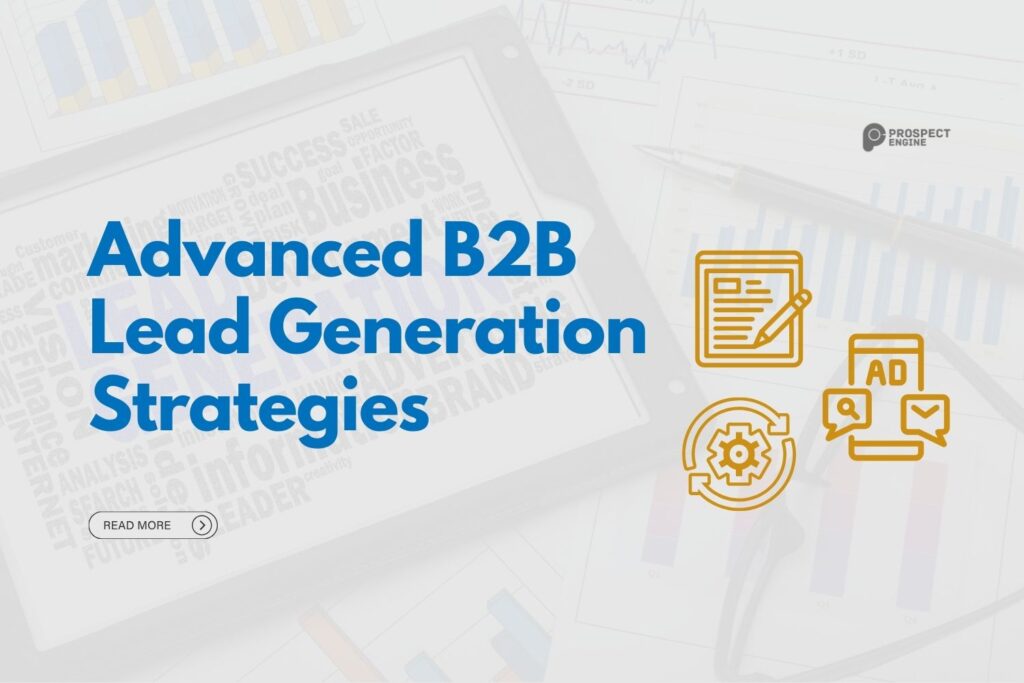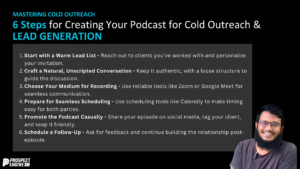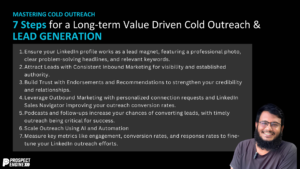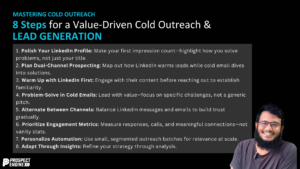Advanced lead generation is crucial for B2B marketers or B2B businesses success, yet many struggle to implement effective strategies. This Advanced B2B Lead Generation Strategies will explore proven techniques to capture and nurture high-quality leads.
We’ll cover:
- Content marketing tactics like webinars, video contents, and guides to attract and engage prospects
- Landing pages and lead capture forms – how to optimize them for higher conversion
- Paid advertising and retargeting strategies to connect with qualified leads
- Actionable tips for SEO and keyword research
- Using marketing automation and AI for predictive lead scoring
- Testing different campaigns and assets to improve ROI
- Social media techniques and networking with influencers
- Developing an advanced lead nurturing strategy across the marketing funnel
Follow this guide to take your B2B lead gen to the next level. Let’s get started!
Key Takeaways From Advanced B2B Lead Generation Strategies
- Successful B2B lead generation requires an integrated strategy spanning multiple channels and tactics.
- Build a solid foundation with inbound content marketing – blogs, videos, guides etc. Promote everywhere.
- Optimize landing pages and forms through rigorous A/B testing and analysis to maximize conversions.
- Combine inbound with paid advertising and retargeting for a balanced approach.
- Leverage intent and account data to identify and target sales qualified leads.
- Marketing automation and AI help scale lead nurturing and routing to sales teams and marketing teams.
- Testing and optimization need to be ongoing processes across campaigns and assets.
- Forge partnerships with industry influencers and develop an engaging social presence.
- Make content interactive, gamify experiences and offer compelling incentives to boost engagement.
- Measure performance continuously and refine strategies based on results and analytics.
With an advanced, comprehensive approach you will generate more high-quality B2B leads and accelerate business growth.
Table of Contents
Content Marketing Strategies for Lead Generation
Content marketing should be a core pillar of any B2B lead generation strategy. By creating valuable, relevant and quality content, you can attract and engage prospects to drive conversions.
Types of Content to Produce
There are several content formats that work well for lead generation:
- Webinars – Hosting webinars is a proven tactic. Include gated registration to capture lead details. Promote widely through email, social media marketing and ads.
- Videos – Short, engaging videos attract attention on social media channels. Embed them on landing pages and gate longer videos behind opt-ins.
- Blogs – Well-optimized blogs that rank for buyer keywords will bring in organic leads. Promote new posts through email address and social.
- Guides and eBooks – In-depth guides and long-form content establish thought leadership. Gate them behind lead capture forms for conversions.
- Case Studies – Real-world examples build trust and credibility. Turn potential customers into advocates with co-created case studies.
Crafting Compelling Content
Follow these tips to create content that converts:
- Personalize your target personas using segmentation. Address their needs and challenges.
- Promote engagement with visuals, assessments, checklists, and interactive elements.
- Make content skimmable – use concise paragraphs, bulleted lists, bold headings.
- Include social proof like testimonials, customer quotes, and reviews.
- Optimize content for organic search with target keywords or search query and metadata.
Lead Nurturing With Content
Map content to each stage of the funnel:
- Top of funnel – Blog posts, guides to attract new leads
- Middle – Detailed content addressing challenges and questions
- Bottom – Case studies, demos proving value proposition
Send personalized recommendations to potential leads based on their intent and funnel stage.
Promote downloads with tailored CTAs in email and onsite messaging.
Repurpose and summarize content into different formats to maximize reach and engagement.
Tracking Content Performance
Analyze content using key metrics like:
- Traffic sources
- Time on page
- Scroll depth
- Social shares
- Downloads
- Leads generated
Test and refine based on metrics. Double down on what performs and eliminate poor performers.
Upgrade old evergreen content with new formats, CTAs and messaging.
Content marketing takes effort but provides a consistent, low-cost source of qualified leads. With the right strategy and advanced techniques, your content will be a lead generation machine.
Optimizing Lead Capture Forms and Landing Pages
To convert your hard-earned traffic into leads, you need high-performing landing pages and lead capture forms. Follow these advanced optimization tips.
Crafting High-Converting Forms
Your forms make or break conversion rates. To maximize lead capture:
- Lead with a strong value proposition and benefit-focused call-to-action.
- Limit fields to only essential info needed to contact the lead. Add more fields progressively.
- Use concise, friendly copy – avoid jargon.
- Allow users to skip fields if they resist providing certain info.
- Include trust indicators like privacy certifications, security seals, etc.
- Pre-populate fields with info you already have about the visitor.
- Test form layouts, flows and fields extensively using A/B testing.
Enhancing Landing Pages
To turn visitors into leads, landing pages must:
- Instantly communicate your value proposition
- Speak directly to the intent of the visitor – use dynamic text replacement to match ads.
- Heavy emphasis on a single, clear call-to-action.
- Use benefit-focused messaging – emphasize how you help prospective customers.
- Include social proof elements – testimonials, reviews, case studies.
- Easy-to-complete, mobile-friendly lead capture form.
- Remove distractions – keep design clean and simple.
Lead Capture Form Optimization Checklist
Follow this checklist to optimize your forms:
- [ ] Strong headline and description
- [ ] Benefit-focused call-to-action
- [ ] Mobile-friendly and responsive
- [ ] Clear value exchange (incentive)
- [ ] Only essential fields required
- [ ] Good use of whitespace
- [ ] Working form validation
- [ ] Trust indicators and security badges
- [ ] Easy-to-notice submit button
- [ ] A/B tested form variations
Continual Optimization
- Use analytics to identify drop-off points in form flows.
- Check forms on different devices.
- Monitor social media platforms and support for feedback.
- Regularly test new layouts, incentivizes and flows.
Refine forms continually based on data and feedback. Small tweaks compound over time.
Leveraging Paid Advertising and Retargeting
Paid advertising and retargeting are powerful tools to connect with qualified leads quickly and efficiently. Here are some advanced strategies to get the most out of these channels.
Paid Search Advertising
Search ads allow you to target users actively searching for solutions like yours. To maximize results:
- Research target keywords thoroughly and group into ad groups around specific topics.
- Create highly relevant ad copy and landing pages tailored to each keyword.
- Use match types like phrase and exact match to hone in on precise searches.
- Build out negative keywords to reduce irrelevant traffic.
- A/B test different ad variations – copy, headlines, call-to-actions.
- Develop landing pages optimized for each ad and keyword.
Social Media Advertising
Social platforms like Facebook and LinkedIn offer advanced targeting based on professional demographics, interests and more.
- Tailor ad creative, offers and landing pages to different personas.
- Test different bidding strategies – consider maximum conversions or target cost-per-lead.
- Make ads and posts engaging and interactive – polls, questions, videos.
- Analyze performance and optimize targeting, creative and placements.
Programmatic & Native Advertising
Programmatic buying and native advertising streamline lead generation:
- Use demand-side platforms to access high-quality inventory efficiently.
- Craft native ads tailored to the style and format of the platform.
- Develop content-style native ads versus overt promotional ads.
- Leverage interest, demographic and intent data to enhance targeting.
- Continually optimize towards cost per lead or conversion metrics.
Retargeting Campaigns
Retargeting past visitors with ads can remarket low-funnel prospects:
- Create custom audiences in Facebook and Google based on site behavior.
- Develop tailored creative and offers for each audience segment.
- Make offers progressively more compelling for colder audiences.
- Use dynamic creative to serve different versions to visitors.
- Set frequency caps carefully – limit over-exposure.
- Expand audiences with similar interests and demographics.
Combine paid advertising platforms and retargeting to accelerate lead generation. Continual testing and optimization based on performance data is key to success.
Keyword Research and SEO (Search Engine Optimization)
Thorough keyword research provides the foundation for an effective SEO strategy. Optimizing content for these keywords will generate targeted leads.
Researching Buyer Keywords
To identify relevant SEO keywords and topics:
- Leverage keyword research tools like Ahrefs, SEMrush and Google Keyword Planner.
- Analyze top ranking pages for your focus keyword – what other keywords do they target?
- Search Google autocomplete and suggested results for keyword ideas.
- Mine SEMrush for questions and long-tail keywords related to your offerings.
- Leverage Google Trends to identify rising searches with great search volume.
- Survey and interview existing customers on their search habits.
Performing Competitor Keyword Analysis
Analyze competitors’ organic presence for keyword opportunities:
- Use SEMrush, Ahrefs or SimilarWeb to analyze their top organic keywords.
- Identify low competition keywords driving significant traffic.
- Assess gaps where competitors rank poorly for relevant searches.
- Spy on their content themes, topics and messaging for inspiration.
Optimizing Pages for SEO Visibility
Optimize existing and new pages targeting focus keywords:
- Include keywords in titles, headers, content, URLs, meta descriptions.
- Create content pillars around topics – interlink for greater relevance.
- Produce long-form, in-depth content to satisfy searcher intent.
- Enhance pages and site for performance – speed, mobile optimization.
- Build high-quality backlinks through content promotion and outreach.
Tracking Keyword Performance
Monitor keyword performance and ranking using:
- Google Analytics – monitor organic traffic from keywords.
- Search Console – track rankings and search impressions.
- SEO tools – check keyword rankings and opportunity.
Continually optimize pages and content for relevance, authority and performance.
SEO takes patience but drives qualified traffic and leads over time. With the right keywords and optimization, it should be a cornerstone of lead generation.
Interactive Content and Gamification
Adding interactive elements and gamification to your content and campaigns can boost engagement and lead capture.
Interactive Content
Interactive content prompts users to engage rather than passively consume information. Tactics include:
- Quizzes and assessments – capture leads through personality tests, needs assessments, etc.
- Calculators and configurators – collect contact details in exchange for custom estimates.
- Interactive demos – gate access to hands-on product demos behind lead forms.
- Interactive content – infographics, videos, presentations with clickable elements.
- Surveys and polls – offer a report for survey completion.
Gamification Techniques
Gamify lead gen experiences by incorporating elements like:
- Points, badges and leaderboards – reward site actions with points and recognize top participants.
- Challenges and quests – encourage users to complete tasks for rewards.
- Progress bars – display progress visuals towards unlocking gated content and offers.
- Time constraints – create urgency with countdown timers on limited offers.
Benefits of Interactive Content and Gamification
Adding these interactive and game-like elements provides many benefits:
- Drives higher engagement and time on site.
- Provides incentives for lead form submission.
- Captures user data and insights.
- Generates social sharing and word-of-mouth.
- Establishes your brand as innovative and fun.
Best Practices
To maximize success:
- Tailor interactive content to your product and audience. Don’t force it.
- Test different interactive content formats – double down on what resonates.
- Make gamification participation optional – avoid alienating users.
- Keep interactive elements simple and intuitive. Avoid confusion.
- Be strategic with gated content – offer real value in exchange for lead data.
With creativity, you can integrate interactive content and gamification elements into multiple touchpoints across the buyer’s journey – driving higher quality engagement and lead generation.
Marketing Automation and AI
Leveraging marketing automation and AI can scale and optimize your lead generation and nurturing processes.
Marketing Automation
Marketing automation platforms streamline repetitive tasks to focus your team on strategy:
- Lead scoring – automatically assign points based on interests and actions.
- Lead routing – send new leads to sales reps based on score, geography etc.
- Lead nurturing – send automated content drips to business leads based on interactions.
- Email marketing – customize journeys triggered by user behaviors.
- Landing pages and forms – create dynamically personalized variations.
- Event management – simplify promotion and follow-ups for webinars.
- CRM integration – sync email, forms, landing pages with your CRM.
AI and Predictive Analytics
AI and machine learning algorithms can optimize decisions:
- Predictive lead scoring – machine learning models to identify hot prospects.
- Content recommendations – suggest related content based on individual interests.
- Ad targeting – find lookalike audiences based on ideal customers.
- Chatbots – engage visitors in real-time with intelligent chatbots.
Getting Started with Automation
Follow these tips to maximize automation success:
- Audit your workflows to identify what to automate first.
- Start small and expand – don’t overcomplicate initial automations.
- Develop detailed buyer personas to personalize effectively.
- Use segmentation, dynamic content and conditional logic.
- Send timely notifications and reminders versus generic drips.
- Integrate with other martech systems – CRM, chat, analytics.
- Analyze performance data continuously and optimize.
With the right foundations and strategy, marketing automation and AI can scale your lead generation process exponentially. Handle higher volumes of qualified leads without expanding headcount.
Leveraging Intent Data and Intelligence
Leveraging intent data and sales intelligence helps you identify and target qualified accounts and contacts.
Understanding Buyer Intent
Buyer intent data tracks prospect research activity to gauge interest and intent. Sources include:
- Bombora – identifies companies researching topics relevant to you.
- Demandbase – tracks site activity to deduce interest level.
- Google Analytics – gain insights from organic traffic sources.
- Social listening – monitor spikes in social mentions.
- Surveys – directly ask prospects how far along in the process they are.
You can then:
- Identify new prospects exhibiting research behavior.
- Segment prospects based on their stage in the buying cycle.
- Personalize marketing with messages matched to their progress.
Enhancing with Sales Intelligence
Sales intelligence provides insights into target accounts:
- Firmographic data – details on company size, revenue, location etc.
- Org charts – map out decision-makers in each account.
- Technographic data – intelligence on technologies used.
- Trigger events – get alerts for new leadership, funding rounds etc.
You can leverage this intel to:
- Identify ideal customer profiles.
- Select targeted accounts within your total addressable market.
- Contact key stakeholders by role and influence.
- Personalize outreach with account-specific insights.
- Time engagement around trigger events.
Impact on Lead Generation
Together, intent data and sales intelligence allow you to:
- Skip upper funnel steps for accounts exhibiting intent. Go straight to leads.
- Qualify out accounts unlikely to have interest or need.
- Double down on qualified accounts matching your ideal customer profile.
- Increase conversions with highly personalized, strategically timed outreach.
Leveraging these advanced techniques will boost conversions from your lead generation campaigns.
Social Media and Networking
Social platforms and influencer marketing enable you to build relationships and promote your lead gen content.
Developing Your Social Media Strategy
A sound social media strategy is key to success. Best practices include:
- Conduct an audit – analyze competitors and conversations relevant to your brand.
- Define your goals – are you driving awareness, generating leads, establishing thought leadership?
- Identify your target audiences and which platforms they are on. Tailor valuable content accordingly.
- Be consistent – plan and schedule content across selected platforms.
- Listen and engage – monitor conversations and interact authentically with followers.
- Promote your content – share blog posts, guides, case studies.
- Run paid social campaigns – amplify reach with promoted posts.
- Analyze and optimize – track campaign performance and iterate.
Networking with Influencers
Partnering with industry influencers lends you credibility while expanding reach.
- Identify relevant influencers – use tools like Buzzsumo to find those with influence over your targets.
- Engage organically – interact with their content, share their posts, comment on their blogs etc.
- Provide value – offer guest posts, data, or quotes before asking for anything in return.
- Collaborate on co-marketing – co-create content, cross-promote webinars or offers.
- Compensate appropriately – pay for their time and promotion, don’t merely expect free promotion.
Social Media Lead Gen Content
Adapt your content formats for each platform:
- Blog articles – promote new posts and link back to your site.
- Videos – create bite-sized videos under 60 seconds tailored to platforms like Instagram.
- Stories – craft compelling ephemeral stories showcasing your brand, events and content.
- Live video – stream Q&As, AMAs, events.
- Carousels – showcase products, testimonials, infographics.
- Hashtags – build communities and tap into conversations around relevant hashtags.
A strategic social media presence, coupled with influencer partnerships, will drive brand awareness, engagement and conversions.
Testing and Optimization
To maximize lead generation, you need to continuously test and optimize your campaigns and assets.
Testing Lead Generation Campaigns
Rigorously test all campaigns before scaling spend:
- A/B test ad creative, landing pages, calls-to-action.
- Test delivery, platforms, placements, bidding strategies.
- Send small segments to new lists before full sends.
- Cap budgets on new keyword groups before expanding.
- Local or regional pilot programs before national launches.
Testing Lead Capture Forms
Forms make or break conversion rates. Optimization techniques:
- Multivariate testing – test multiple variables simultaneously.
- A/B testing – test one variation against the control.
- Test field types, labels, validations and flows.
- Try different incentives and value propositions.
- Iterate on design, layout and placement.
Testing Lead Nurturing Campaigns
Test and refine your nurturing programs:
- Send A/B tests of email content and subject lines.
- Test segmentation and personalization strategies.
- Compare scheduling frequencies and timing.
- Iterate on content mapping to funnel stage.
Analytics for Optimization
Leverage data to identify optimization opportunities:
- Web analytics – assess visitor behavior, funnel drop-off.
- Campaign analytics – open rates, clicks, unsubscribes.
- Attribution modeling – quantify channel contributions.
- Surveys – get direct feedback from prospects.
- CRM data – win rates for sales pipeline stages and reps.
Apply learnings across campaigns and assets to boost performance. Optimization is a continuous process.
Developing a Lead Nurturing Strategy
Lead nurturing is essential to guide prospects through the buyer’s journey to conversion.
Defining Buyer Stages
Map content to your sales funnel stages:
- Awareness: Provide education – guides, blogs, videos – to pique interest.
- Consideration: Address common pain points and questions with detailed content.
- Evaluation: Supply case studies, demos, and trials to showcase your solution.
- Conversion: Send pricing, proposals, contracts to facilitate purchase.
Lead Scoring
Analyze lead behavior to determine sales-readiness:
- Profile completion and field values
- Email opens and clicks
- Content downloads and site pages viewed
- Form submissions
- Demo and free trial sign-ups
Score profiles based on activity and define thresholds to determine sales-readiness.
Lead Segmentation
Divide leads into groups for targeted nurturing:
- Persona – Content specific to job title and role challenges.
- Funnel stage – Content matched to current phase.
- Engagement level – Offers and information based on activity score.
- Demographics – Vertical, company size, location etc.
Personalized Content Recommendations
Craft targeted content for each segment:
- New contacts: Provide overview education to pique interest.
- Disengaged leads: Send re-engagement content with new information.
- Almost ready leads: Share evaluation-stage content like demos.
- Sales qualified leads: Supply proposals, contracts to convert.
Automated Lead Nurturing
Leverage marketing automation to scale lead nurturing and provide a personalized experience.
Measurement
Track key metrics to refine your nurturing strategy:
- Open and click-through rates
- Content consumption
- Form submissions
- Sales qualified lead growth
- Marketing influenced pipeline
Nurture leads strategically through their journey to become sales qualified.
Frequently Asked Questions
Still have questions about advanced B2B lead generation strategies? Here are answers to some common FAQs.
- What are the most important metrics for lead generation?
Key metrics to track include:
- Cost per lead – monitor campaign costs versus leads generated. Lower is better.
- Lead to customer conversion rate – percentage of leads that become high-value customers. Optimize towards higher conversion.
- Sales qualified lead growth – measures effectiveness of lead nurturing process.
- Marketing influenced pipeline – tracks pipeline driven by marketing campaigns.
- Revenue attributable to marketing – calculates marketing’s contribution to won deals.
- How can I tell if my lead generation campaigns are working?
Analyze performance against goals and past campaigns, and optimize as needed:
- Traffic, engagement, conversions decreasing? Try new creatives or offers.
- High lead volume but low conversion rate? Review lead scoring and nurturing process.
- Poor sales process uptake of leads? Improve lead qualification and personalization.
- Strong early pipeline but drop-off at later stages? Introduce more evaluation stage content.
Continuous optimization based on data is key to improving results.
- What are the best practices for lead nurturing emails?
Follow these best practices for effective nurturing emails:
- Segment your lists based on persona, interests, funnel stage.
- Make subject lines and preheaders personalized and compelling.
- Send timely, relevant content that moves prospects to the next step.
- Include clear calls-to-action to drive conversions.
- Get creative! Try different formats like polls and quizzes.
- Test emails rigorously and analyze performance data.
- How do I build an effective content strategy for lead gen?
Elements of an effective B2B content strategy include:
- Map content to each funnel stage – blogs, case studies, demos, etc.
- Develop buyer personas and tailor content to their needs.
- Promote content heavily across all channels.
- Gate gated assets like ebooks and toolkits with lead forms.
- Repurpose and summarize content into multiple formats.
- Analyze performance to double down on what works.
- What are some creative ways to generate B2B leads?
Get creative with lead gen campaigns. Tactics like direct mail, referral rewards, quizzes, and even old-fashioned cold calling can still be very effective when done right. The key is relevance and value – avoid gimmicks that don’t truly resonate with your audience. Test new ideas to break through the noise in inboxes.
Conclusion
Advanced B2B lead generation requires a multifaceted strategy encompassing content, digital ads, optimization, and nurturing across platforms. By tailoring campaigns to buyer intent data and personas, promoting engagement through interactivity, leveraging automation and AI, and continually testing and improving performance, you can achieve lead generation excellence. With these proven tactics, you’ll convert more prospects to customers, accelerate growth and gain a sustainable competitive advantage. Content, personalization, analytics and automation are the cornerstones of cutting-edge B2B lead generation.





